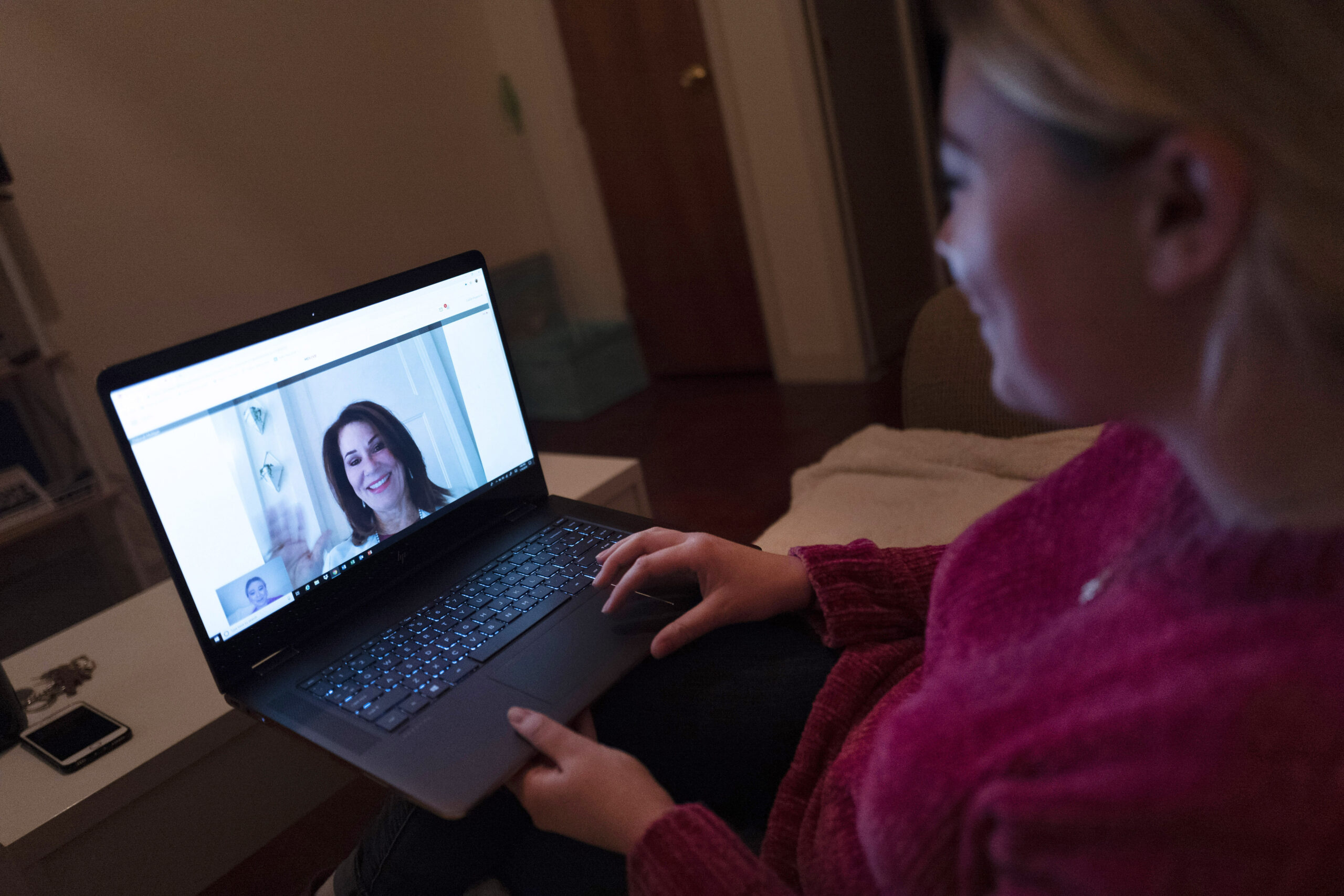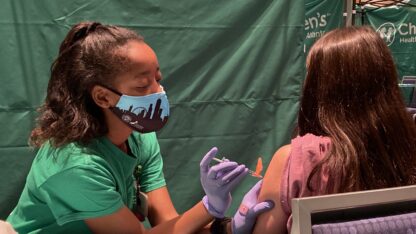A Note from the Georgia Health News editor Andy Miller: Chances are that if you have needed routine medical care during the pandemic, you received it in front of a computer screen.
But telemedicine couldn’t help what ailed me recently.
After having my temperature taken outside the office, I arrived in a near-empty waiting room. Soon a physician examined the insides of my ears, nose and throat with a scope before figuring out what was wrong. It was pain literally in my neck, causing me to have aggravating pressure in my ear.
Problem solved with hands-on care.
Yet that’s not to take away from the surge of telemedicine, which appears to have arrived as a vital tool. And it looks like it’s here to stay, post-pandemic.
Here’s an article about this digital growth.
The family medicine practice where Jamekia Kitchens works adopted telemedicine this March.
Like many providers across the nation, the nurse practitioner in Sandersville, in Washington County, prefers her patients to stay home as much as possible to reduce the risk of COVID-19 exposure.
But Georgia faces a telemedicine dilemma. with which Kitchens is personally familiar.
The state has long been friendly to health IT, including telemedicine, and Kitchens is using software developed in Georgia to connect with her patients. But her own grandmother — who lives just 10 miles away from the practice — lacks the broadband Internet access that’s needed for a remote video session.
At least one-third of Washington County’s households lack broadband access, according to the Georgia Broadband Deployment initiative, and that’s true of many other rural areas of the state.
Though telemedicine is not available to everyone, demand for it has surged in Georgia during the pandemic. And increased use of it has been propelled by sweeping regulatory changes announced by the federal government in March and April. These changes lifted longstanding barriers to use of the technology.
Industry observers agree that even as regular in-person health care slowly returns, telemedicine will continue to be much more important than it was before the pandemic.
Deregulation Amid An Emergency
Prior to COVID-19, Medicare reimbursed providers for telemedicine services only when they were in rural areas or in places with health care shortages. Patients also had to travel to an “originating site” such as a clinic to use telemedicine. They could not use telemedicine from home.
The rules prevented clinics like the one Ann Rosenbaum administers in suburban Atlanta from adopting telemedicine.
Since the clinic she administers, Southeastern Endocrine and Diabetes, was not rural, it could not bill Medicare for telemedicine services
After an initial round of federal changes in March opening up telemedicine to non-rural Medicare providers, Rosenbaum’s practice adopted the free doxy.me platform so patients and providers could consult while staying home.
Rosenbaum says many of her patients now love telemedicine. It has eliminated the need to drive or get rides in Atlanta traffic, and it has made life easier for older patients and others who have limited mobility, she said.
Doctors and others say some patients continue to prefer the phone. The federal government recently announced that telephone calls would be reimbursed by Medicare at the same rates as in-person or telemedicine visits for many services, and the change has been made retroactive to the start of the emergency, March 1. This action is a boon to cash-strapped medical practices, which have reported declining office visits and lower revenues in the past few months.
Federal guidance also added physical therapists, occupational therapists, and speech language pathologists to the list of professionals who can use telemedicine. It has widened access to some at-home health services as well.
Georgia made its own moves last year to expand telemedicine. A recently approved state law requires that private insurers pay doctors and other health care providers for telemedicine services at the same rate as for in-person visits. A second new law eased licensing for out-of-state providers.
Even before the pandemic, Georgia’s Medicaid program reimbursed providers for telemedicine services at the same rate as for in-person visits, which was also the policy in almost all other states. Georgia has now received permission from the federal government to use telemedicine services for Medicaid patients with intellectual and developmental disabilities. These range from physical therapy to nursing to care coordination.
The Human Factor
Telehealth, while it has real advantages, runs the risk of seeming impersonal, reducing the traditional connection between a provider and a patient.
Athens mental health providers Stephen Fleming and Chris Mayo have been doing exclusively telehealth appointments with their clients during the pandemic, and both will continue to do so until in-patient appointments are safe again.
Although telehealth is a valuable tool when it comes to continuity of care, Mayo, a licensed clinical social worker, prefers face-to-face sessions.
“I feel I can provide a higher quality of service when I observe full body language, have fewer distractions and no technology glitches,” he said.
Fleming, a psychiatrist, said he makes every effort to provide clients with the same experience in a telehealth session as they would have in an actual office visit. While he misses the personal connection, he is also able to see the positives.
“I also appreciate how telehealth allows clients to engage me on their terms and invite me into their homes, workspaces, etc., where they feel most comfortable,” he said.
Businesses Do Their Part
Georgia is home to several telemedicine companies. They report a major increase in demand for their services since the COVID-19 pandemic began.
Prior to the pandemic, Azalea Health’s telemedicine platform averaged 500 sessions per month. The company is now providing 15,000 a month.
Azalea is offering its telemedicine platform for free during the national crisis. The company said this offer could last as long as a year, “depending on need.”
The Global Partnership for Telehealth, headquartered in Blackshear, is now teaming up with the Georgia Rural Health Innovation Center based at Mercer University to offer its telehealth software to rural providers for free for six months, according to a press release.
Insurance companies in Georgia are seeing consumers turn increasingly to the companies’ own in-house telemedicine services.
Anthem and UnitedHealthcare are making telemedicine free almost across the board by waiving customers’ cost-sharing, at least until mid-June.
“The increased volume we are seeing is unprecedented,” said Christina Gaines, corporate communications director for Anthem. She reported more than 175,000 downloads nationwide since the start of 2020 and a 250 percent increase in completed visits to Anthem’s telehealth platform over the same period in previous years. Anthem also recently launched a teledentistry program.
The Uninsured
The 14 percent of Georgians without any health insurance are being left out of the telemedicine conversation, argues Michael Giglio. He’s a co-founder of Giving Health, a nonprofit headquartered in Atlanta that is working to provide free telehealth to such people.
Many uninsured people go without care because they can’t afford it. The goal of Giving Health is to provide them with free telemedicine — including standard medical care and behavioral health services — in their homes on a 24/7 basis.
The nonprofit says it will cost about $100 to provide an entire family with this service for a year, and donations are needed to help fund the effort.
For patients who have significant transportation and scheduling challenges, the ability to consult with a health care provider from home is a big improvement.
Now patients can go from requesting contact to seeing a doctor in under an hour, simply by clicking on a link that comes to their phones via text.
Giving Health already has about 50 patients on its rolls. Giglio says telehealth is just one part of the solution for medical needs of the uninsured.
The group has teamed up with the Good Samaritan Health Center, which serves a largely homeless and uninsured population on Atlanta’s west side, and with the Veterans Empowerment Organization.
Patients who call Good Samaritan’s COVID-19 hotline, for example, are routed to Giving Health’s telemedicine service, if they can receive care at home.
Rebecca Grapevine writes about public health in the United States and India. She has worked in clinics and hospitals and in both countries and holds a doctorate in history from the University of Michigan.
Freelance journalist Naomi Thomas contributed to this article.









